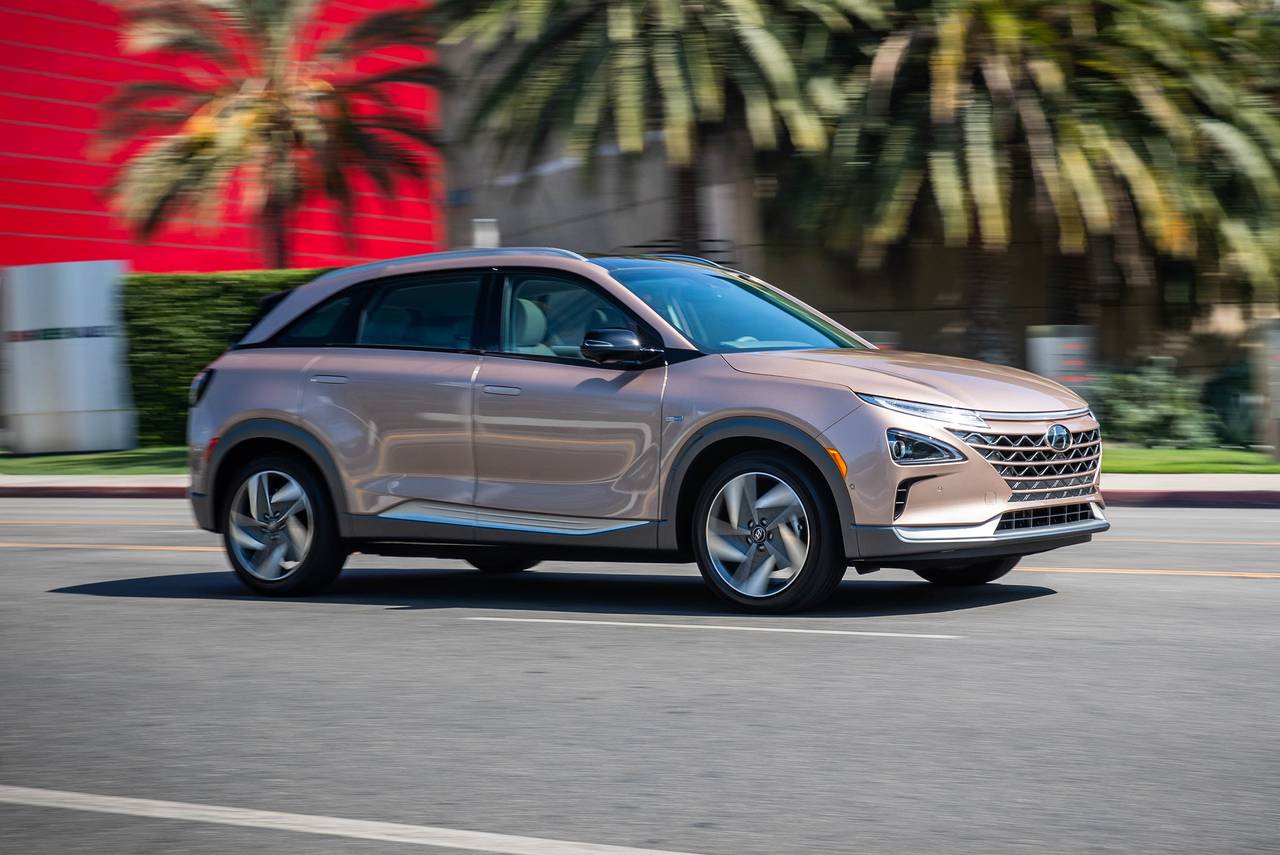There are an estimated 240 million passenger cars and trucks on the road in the U.S. today. And while several million are "clean vehicles" running on electricity, only about 18,000 of those are fuel cell electric vehicles.
All of them are only sold in California, and there are only three choices — Toyota's Mirai sedan, Hyundai's Nexo SUV and Honda's CR-V e:FCEV, a unique plug-in hybrid fuel cell version of the popular CR-V SUV.
Fuel cell electric vehicles make a lot of sense on paper. They have no environmentally damaging or physically harmful tailpipe emissions, can travel as far as most gasoline-fueled vehicles on each fill-up, and can be refueled in five minutes or so. They've been available for more than a decade now and are made by auto companies with great reputations.
So why do they account for a negligible 0.006% of the total vehicle fleet?
Fuel cell vs. battery
For the consumer, there's little difference between fuel cell electric vehicles and battery electric vehicles in terms of the driving experience. Both use electric motors to power their wheels and, depending on how their power delivery systems are tuned, both can deliver lots of torque — although most fuel cell vehicles are tuned for maximum fuel efficiency and aren't as gutsy as the average EV.
Both are, in fact, electric vehicles. The big difference is in how the electricity is produced.
Traditional EVs carry large, heavy battery packs charged by plugging into the nationwide electrical power grid. Fuel cell electrics — or FCEVs — carry pressurized tanks of hydrogen gas and are filled at hydrogen fueling stations, which right now are available only in California and on Hawaii's Oahu island.
The hydrogen gas is then fed into a fuel cell stack where it mixes with oxygen. A thermochemical process in the stack strips the electrons from the hydrogen atoms to produce electricity that is fed directly to the FCEV's motor with any excess going to a relatively small storage battery for use when an extra surge of power is needed.
Nice wheels
Reviewers, including Edmunds, have found Toyota's Mirai sedan to be one of the best cars in Toyota's stable, with great styling, a luxurious ride, surprisingly good handling, an excellent and high-quality interior, and good build quality. The Hyundai Nexo, a small five-passenger crossover SUV, also is lauded for its quality build, upscale design and features, high-end technology and excellent ride characteristics.
Honda's CR-V e:FCEV isn't hitting the market until this fall, but early reviews are congratulating the automaker for making hydrogen a bit more practical by combining it with a small rechargeable battery pack that's good for up to 29 miles of driving before H2 consumption begins. Despite a name that could trip up the most nimble-tongued, the hydrogen Honda gets props for being more fun to drive, with better handling and ride quality than the standard CR-V Hybrid.
Where does hydrogen come from?
Hydrogen isn't actually a fuel, but a fuel (or energy) carrier. It's the electrons in the hydrogen atoms that provide the fuel.
While it is the most common element known, hydrogen doesn't exist in a pure form. It is always bound to something else, like water — think H2O, which is two parts hydrogen and one part oxygen. The hydrogen atoms have to be separated from their partners, a process that takes tremendous amounts of energy.
Natural gas, or CH4, has a high hydrogen content and is the most common source of hydrogen for fuel. It is broken down under high heat, usually by injecting steam. Water is another source; the hydrogen is split from the oxygen by injecting an electrical current in a process called electrolysis.
Is hydrogen clean?
Neither process is as energy-efficient as merely generating electricity and storing it in a battery, but a number of studies have shown that if the electricity used to produce, compress and chill hydrogen gas is generated using renewable fuels, using hydrogen is a cleaner process than drilling, transporting and refining crude oil. Generating electricity, except from coal, is cleanest of all.
FCEVs are cleaner to operate than internal combustion engine (ICE) vehicles — the only thing emitted from a fuel cell stack is water vapor formed when the hydrogen gas combines with oxygen in the fuel cell stack.
Finally, fuel cell electric vehicles are much more efficient than ICE vehicles at using energy, turning about 75% of the energy in their fuel tanks into power to drive the wheels. Compare that to 40% for the typical modern ICE vehicle. Battery electric vehicles are king, though, with an average efficiency of about 95%.
The refueling dilemma
Fuel cell electric vehicle drivers are handicapped by the relative dearth of fueling places. While EV drivers can charge at home and on the road in every state in the nation, FCEV drivers don't have many fueling choices.
Because of its volatility and the need to store it at icy temperatures and very high pressure, hydrogen isn't suitable for storage or production at home. For fuel cell electric vehicles, it is compressed to 10,000 pounds per square inch. Storage at that pressure requires refrigeration at minus 40 degrees Fahrenheit. Special storage tanks, delivery lines and supply nozzles are needed for safety. A hydrogen fuel station with just a single dispenser can cost upward of $2 million.
To date, only California and Hawaii have publically available hydrogen stations, thanks to government initiatives that have helped subsidize them and promote sales of FCEVs. Hawaii has just one station, near Honolulu, while California has 55, clustered in the San Francisco Bay and metropolitan Sacramento areas and Southern California.
In contrast, there are 10,010 publicly available DC fast-charging stations and 55,237 Level 2 EV charging stations spread across all 50 states and Puerto Rico, according to the most recent count on the Department of Energy's Alternative Fuels Data Center.
Fuel cost crisis
A kilogram of compressed hydrogen fuel for an FCEV is the energy equal to a gallon of regular gasoline. When the first FCEVs hit dealerships in California, hydrogen fuel was sold for around $16 a kilogram, equal to $8 a gallon for gas. But FCEVs average the equivalent of 66 mpg, while average fuel economy today for ICE vehicles is under 30 mpg. When hydrogen was $16 a kilogram, the cost of fueling per mile driven wasn't an issue.
Fast-forward to 2024 and a shortage of hydrogen fuel — related to low sales of FCEVs and thus low demand for that fuel — has driven prices higher than a hydrogen-filled balloon can fly. Depending on the station, prices these days range from $23 to $36 a kilogram.
To help counter the cost, both Toyota and Hyundai provide up to $15,000 worth of free fueling with their FCEVs; Honda hasn't announced fuel plans for its hydrogen-electricity hybrid. But the supply shortage means many California stations are unable to operate on a regular basis, and free fuel is only a perk if you can find it.
Good buys for the wrong reasons
Fuel cell electric vehicles are complex and built in such small volumes that they almost rate as being handmade. Low volume means no economies of scale, so these vehicles are priced higher than similar gas-fed counterparts.
That well-reviewed Toyota Mirai starts at $51,285 including delivery for the base XLE model and jumps to $68,210 for the more upscale Limited. That's a lot for a Toyota sedan. Hyundai's Nexo suffers the same pricing fate: The base model of the compact crossover starts at $61,470 including delivery; the upper trim is $64,920.
People haven't been lining up to buy at those prices, so Toyota and Hyundai have offered steep discounts in recent years — up to $35,000 on the Nexo and $30,000 on the Mirai Limited and $22,000 on the XLE.
On the used front, late-model Mirais typically sell in the $15,000 to $20,000 range; first-generation models can be had for under $10,000. Used Nexos are usually found in the the range of $10,000 to $18,000. Used Honda Clarity FCEVs are hard to find because few were sold new and they were discontinued three years ago.
What's the future hold?
No one is giving up on hydrogen, but attention has shifted from passenger vehicles to commercial trucks and heavy construction equipment. Companies including Toyota, Hyundai, Stellantis, Honda, General Motors and Volvo Trucks all have products in the market or being readied.
To serve these trucks as they begin appearing on U.S. highways, plans are underway for a national network of hydrogen truck stops.
All of that has positive repercussions in the passenger car arena.
More FCEV trucks mean more demand for fuel-grade hydrogen, which would lower prices and increase availability. Most hydrogen truck stops also will have H2 pumps for passenger vehicles, opening new markets for them and making long-distance travel in clean fuel cell electric vehicles a possibility.
Battery electric vehicles still are likely to be less expensive with a public charging system that offers far more outlets than will a nascent hydrogen fuel station network.
But fuel cell electric vehicles' fast refueling and long-range capabilities — one version of the Toyota Mirai is rated at just over 400 miles — could make them attractive enough to create measurable demand in the passenger vehicle market if the cost of hydrogen ever goes down and availability increases.

 by
by